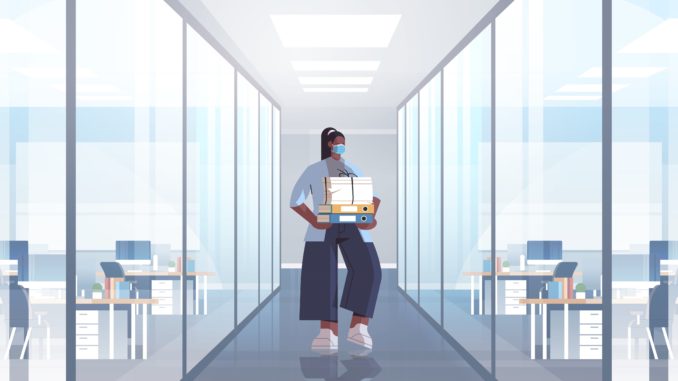
As many people return to the office for the first time in more than 18 months, personal safety, and security of possessions in the ‘new normal’ of how workspaces function, needs to be considered.
As we move into Autumn an ever-increasing number of people are returning to their workplaces – at least for some days of the week – but, in many cases, it is not a return to business as usual. The COVID-19 pandemic has changed how many spaces are used and, while safety of employees is important – in terms of not being exposed to viruses – security of possessions should not be ignored.
As Simon Howorth, marketing and design manager at Dams notes, the work environment is changing in design and purpose. “Employees are re-evaluating how they would like to work – at home, in a coffee shop, in the office, hot-desking or a hybrid working model,” he says. “In return, many businesses are considering what the impact will be of continued remote-work policies on office occupancy rates which will, in turn, have an impact on the security of important business documents and employees’ personal belongings when they are in the office.
“Take hot-desking or co-working spaces as an example; these work on a first-come, first-served basis, which means if you like a particular space then you have to come early to take that seat or else it might not be available. Security, or lack thereof, is a challenge that businesses will encounter due to transient design. Poor implementations can make it hard for individual employees to securely store their personal belongings.”
Simon adds that secure storage areas are available that can be used in hot-desking and co-working environments. “It’s advisable for companies which adopt these work practises to offer similar storage areas for their employees, too,” he adds. “Wooden and steel storage lockers cover a variety of storage solutions that cater for employees’ personal effects, clothing and possessions in all office and workplace environments. Lockers are the perfect storage solution for hot-desking spaces to keep business premises not only functional but also clutter-free.”
Leon Haigh, UK sales manager at Phoenix Safe, adds that physical security products, like safes, still play a big role. “Especially when considering the need of business owners to protect employee records, to maintain their GDPR compliance or just to protect their own paper or data records from theft or fire.”
Personal safety
But safety when working in an office is now about much more than keeping possessions safe; it involves keeping employees healthy, and limiting their exposure to harmful germs – be they the latest variant of COVID-19 or other infectious viruses. As Steve Plaistowe, business development manager for the Office Products Supplies Channel at Spectrum Industrial notes, colds and ‘flu cost UK employers 28.2 million working days in 2018/19, according to the UK Labour Force Study, costing businesses £28.9 million in sick days, the ONS reported.
He adds that when an employee has cold or ‘flu it can spread to as much as 40% of the workplace, according to data from the University of Pittsburgh. The worst month for sick days is January, with 53% more taken than in any other month, annualleave.com reports. “It’s important that businesses put measures in place to help prevent the spread of all viruses,” Steve says.
“Among the many things learnt over the past 18 months of the pandemic, a key factor in maintaining our own health is good hand hygiene. The need to practice regular and effective washing and sanitising of our hands will remain of high importance in the ongoing battle to suppress the virus, enabling us all to lead our lives as close to the pre-pandemic ‘normal’ as possible.
“The predictions around other respiratory illnesses, and the increase in colds and ‘flu during the winter months, means workplaces need to ensure they don’t lose momentum around hygiene in the workplace.”
Signs of the times
According to Steve signage is ideal way to inform employees of areas that need to be cleaned down after use – as well as informing employees and visitors when areas were last attended to. “Washrooms are an area where, for sanitary reasons, hands should be washed anyway; this represents a great opportunity to remind about the need for regular and effective handwashing and sanitisation,” he explains.
“To keep this at the forefront of minds, placement of washroom-orientated safety signage – throughout a building as well as close to the washroom location itself – will certainly help. Once in the washroom, reminders about effective handwashing techniques via safety signs and safety posters will also help focus on actions to achieve good sanitary management.
“Safety signs to remind and promote good sanitary practice are typically of the ‘mandatory’ type, providing instruction on what ‘must’ be done. Washroom safety signs should be placed in locations that allow them to be highly visible, should be of a size to enable them to be clearly read from distance, and of a material durabile enough for the environment.”
Washrooms also have several other hazards that staff must contend with, such as hot water taps and slippery floor conditions. “In these instances, hazard warning safety signs, along with more floor graphics and A-boards highlighting the hazards, are all relevant solutions to protect the person from harm and injury, “ says Steve.
“Ultimately, as part of the wider safety obligations, washroom safety signage forms part of the solution that will maintain a feeling of security for all.”


Be the first to comment